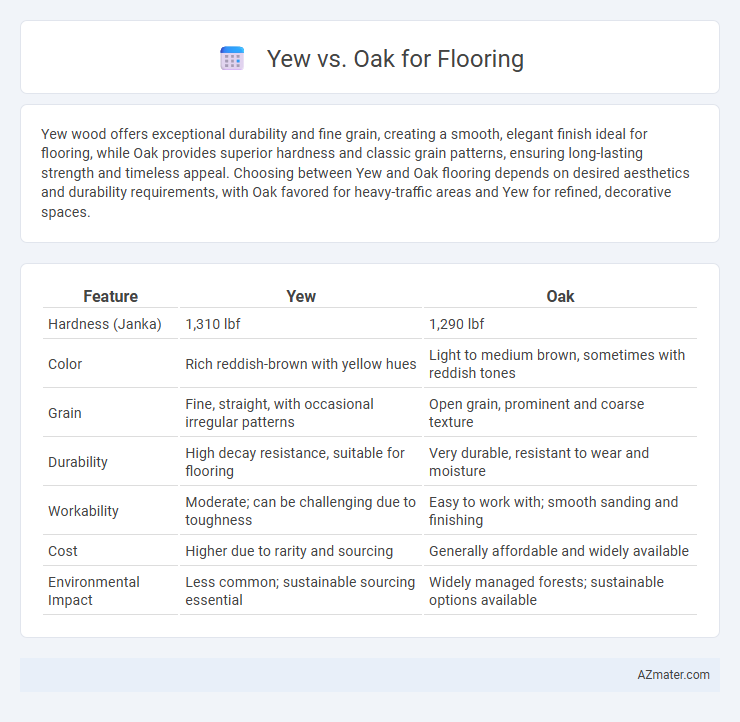Yew wood offers exceptional durability and fine grain, creating a smooth, elegant finish ideal for flooring, while Oak provides superior hardness and classic grain patterns, ensuring long-lasting strength and timeless appeal. Choosing between Yew and Oak flooring depends on desired aesthetics and durability requirements, with Oak favored for heavy-traffic areas and Yew for refined, decorative spaces.
Table of Comparison
| Feature | Yew | Oak |
|---|---|---|
| Hardness (Janka) | 1,310 lbf | 1,290 lbf |
| Color | Rich reddish-brown with yellow hues | Light to medium brown, sometimes with reddish tones |
| Grain | Fine, straight, with occasional irregular patterns | Open grain, prominent and coarse texture |
| Durability | High decay resistance, suitable for flooring | Very durable, resistant to wear and moisture |
| Workability | Moderate; can be challenging due to toughness | Easy to work with; smooth sanding and finishing |
| Cost | Higher due to rarity and sourcing | Generally affordable and widely available |
| Environmental Impact | Less common; sustainable sourcing essential | Widely managed forests; sustainable options available |
Introduction to Yew and Oak Flooring
Yew flooring offers a rich, warm hue with fine, tight grain patterns, known for its durability and natural resistance to moisture and decay. Oak flooring, widely favored for its strength and versatility, presents prominent grain and a range of tones from light to medium brown that complement various interior styles. Both woods provide excellent longevity, with yew prized for its distinctive color variation and oak recognized for its classic appeal and resilience.
Botanical Differences Between Yew and Oak
Yew (Taxus baccata) and Oak (Quercus spp.) differ significantly in botanical characteristics; Yew is a coniferous evergreen tree with needle-like leaves and red arils, while Oak is a deciduous hardwood with broad lobed leaves and acorns. The cellular structure of Yew wood is dense and fine-grained, contributing to its smooth texture, whereas Oak wood features prominent growth rings and a coarse grain pattern due to its diffuse-porous vessel arrangement. These botanical distinctions influence the physical properties, appearance, and durability of Yew and Oak flooring.
Appearance: Color and Grain Patterns
Yew flooring features rich golden-yellow to reddish-brown hues with fine, straight grain patterns that create a smooth, elegant surface ideal for warm, inviting interiors. Oak flooring offers a broader palette, from light tan to deep brown, showcasing prominent, distinctive grain lines and occasional knots that add rustic charm and character. The choice between Yew and Oak depends on whether a subtle, refined look or a bold, textured appearance is preferred for the flooring design.
Durability and Hardness Comparison
Yew flooring offers moderate durability with a Janka hardness rating around 1,000, making it softer and more prone to dents than oak. Oak, particularly red and white variants, boasts higher hardness levels ranging from 1,290 to 1,360, providing superior resistance to wear and impact. The significant difference in hardness makes oak a more durable choice ideal for high-traffic areas, while yew's softer nature suits low-traffic or decorative applications.
Maintenance and Care Requirements
Yew flooring requires moderate maintenance due to its softer wood structure, necessitating regular cleaning to prevent dents and scratches, while oak flooring offers greater durability and is more resistant to wear and tear with less frequent upkeep. Oak's dense grain and hardness make it easier to refinish and restore, whereas yew may need more careful handling and specialized care products to maintain its appearance. Both types benefit from controlled humidity levels and protective coatings to extend their lifespan and preserve natural beauty.
Cost and Availability of Yew vs Oak
Yew flooring generally commands a higher price than oak due to its rarity and slower growth, making it less available in the market. Oak is widely accessible and more cost-effective, favored for its abundance and faster harvesting cycles. The limited supply of yew results in premium pricing and potential delays, whereas oak offers a budget-friendly and readily obtainable flooring option.
Environmental Impact and Sustainability
Yew flooring offers a sustainable choice due to its fast growth rate and ability to regenerate quickly, minimizing deforestation impact. Oak, while durable and long-lasting, grows slower and its harvesting can contribute to habitat disruption and increased carbon footprint. Choosing yew supports environmental conservation by promoting renewable resource use and reducing overall ecological impact in flooring applications.
Installation Methods and Considerations
Yew flooring requires careful moisture control and acclimation due to its dense grain and natural oils, often installed using nail-down or floating methods to prevent warping. Oak, favored for its hardness and stability, supports a variety of installation techniques including nail-down, glue-down, and floating, providing flexibility for both engineered and solid planks. Both woods demand proper subfloor preparation and acclimation periods to ensure long-term durability and performance in varying indoor climates.
Popular Design Styles for Yew and Oak Floors
Yew flooring is prized in traditional and rustic design styles, offering warm, reddish hues and tight grain patterns that enhance country cottages and classic interiors. Oak floors dominate in both contemporary and farmhouse aesthetics, with their durable structure and versatile grain ranging from light to medium brown tones that complement minimalist and modern rustic decors. The natural characteristics of yew bring a unique, elegant flair, while oak provides robust, timeless appeal suited for high-traffic residential and commercial spaces.
Pros and Cons: Yew vs Oak for Flooring
Yew flooring offers a unique reddish hue and natural resistance to decay, making it ideal for aesthetics and longevity, but it can be more prone to dents due to its softer nature compared to oak. Oak flooring is highly durable with exceptional hardness, providing excellent wear resistance and suitability for high-traffic areas, though it can be more expensive and prone to discoloration over time. Both woods present distinct grain patterns and colors, requiring consideration of style preferences, budget, and maintenance needs when choosing between yew and oak for flooring.

Infographic: Yew vs Oak for Flooring
 azmater.com
azmater.com